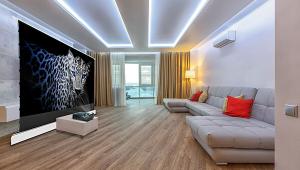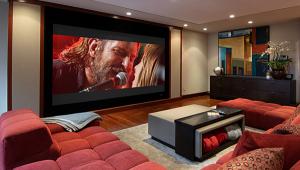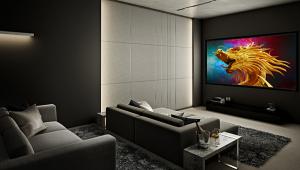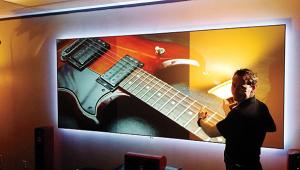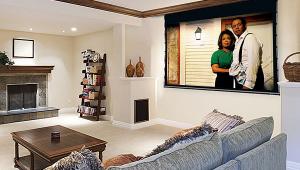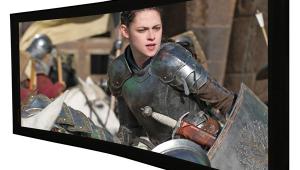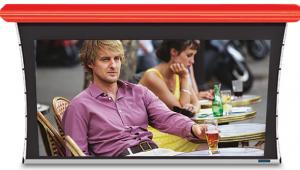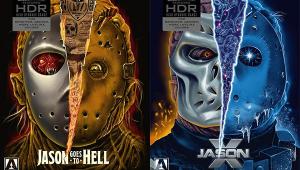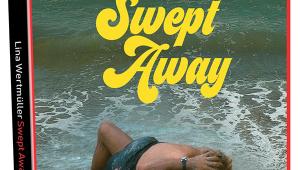It would be great if you could do a comparison of the Acoustic Transparent Screen vs Non AT of the same model. Perhaps a 2 parts series; part 1 with emphasis on video, part 2 with audio.
I am in the process of building a dark cave. The StudioTek 130 G3 AT screen cost twice as much as non AT screen. Does AT have twice the quality as Non AT?
Stewart Filmscreen StudioTek 100 Screen
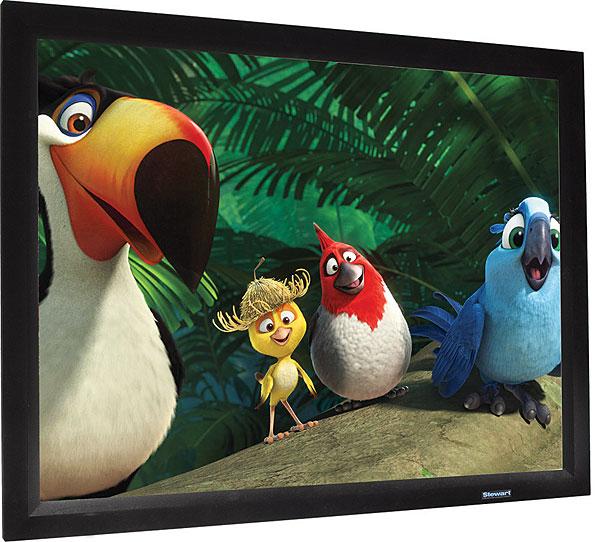
AT A GLANCE
Plus
Pristine image with no obvious artifacts
Nearly perfect brightness and color uniformity
Minus
Performance hinges a lot on room
May not provide the gain needed to achieve desired brightness
THE VERDICT
The StudioTek 100 provides the most accurate picture I’ve ever seen from a screen at home. While it demands a truly dark viewing environment—and a bright projector—it’s worth the effort if you want the best image possible.
Your video playback system is like any other part of your home theater: It is only as good as its weakest component. In the last five years, massive improvements have been made in both video sources and playback systems, but we’ve also seen a huge growth in the options for projection screen materials. There are new designs that bring great flexibility, allowing customers to do front projection in rooms that they never would have considered before. But most of the time, just like with fancy video processing, these new, exotic materials give you one thing but take away another, imparting visible artifacts to the image such as sparkles, texturing, and hotspotting. Enter the Stewart Filmscreen StudioTek 100. A long-available standby now almost forgotten in a wave of new-fangled, high-ambient-light screen introductions, it has for years been delivering one of the purest imaging surfaces on the market.
A Glimpse of the Past
There are a lot of first-rate screen manufacturers today, but Stewart has become a legend in the business, delivering the reference screens used in nearly every post house, screening room, and theatrical venue. While their screens typically cost more than those of some of the competition, their materials and craftsmanship are consistently top-rate. I’ve been using Stewart screens in my reference home theater for more than a decade, and though I’ve seen some excellent models from other companies, I continue to rely on the Stewarts.
For the last 10 years, I’ve been using what many have called the industry reference, the Stewart StudioTek 130. This is a screen that has a gain of 1.3, giving you a 30-percent boost in light level over a large percentage of the surface compared with the light hitting the screen. This is done with a special coating that not only gives you a boost in luminance but also rejects some of the light coming in from more extreme angles. The key benefit to this is a bit of ambient light rejection, which can help with ANSI-measured contrast. Tom Norton reviewed the StudioTek 130 when the latest G3 version was released (Home Theater, July 2010, and soundandvision.com). I upgraded to this material right around that time and have been ecstatic with its performance ever since.
That doesn’t mean the StudioTek 130 was completely “transparent” to the viewing experience, though. Ultimately, you want a screen that takes nothing away from the video you’re displaying on it but also doesn’t add anything. Technically, this is probably impossible since there will always be some kind of texture, no matter how small, to allow for the proper reflection of the light hitting the screen. The StudioTek 130 does show signs of texturing if you look for it in the brightest areas of the picture. At times, this looks like a subtle amount of film grain, but since it doesn’t move, it looks unnatural compared with the rest of the image. As projectors have gotten brighter, and our standards of viewing have demanded a bit more brightness, this artifact has become slightly more noticeable, though I still wouldn’t call it intrusive. In fact, I would say that the majority of viewers wouldn’t even see it if I pointed it out. But like all artifacts, once you see it, it becomes hard to ignore.
A Tale of Two Materials
The StudioTek 100 is very similar to the StudioTek 130 in that it aims to provide excellent color and light uniformity and keep texture to an absolute minimum, giving you an image that is devoid of artifacts attributed to the screen material. But because the StudioTek 100 doesn’t try to add gain (its specified gain is 1.0), it lacks the subtle texturing you may see with the StudioTek 130. That screen is slightly brighter in the center than it is at the outer edges—one of the byproducts of adding gain and rejecting light coming in from other angles.
The StudioTek 100 doesn’t have that problem, boasting nearly perfect light uniformity across its entire surface. So, while the light reflecting back at you from the center of the image isn’t quite as bright as it would be from a StudioTek 130, the image actually looks a bit more consistent in brightness across the entire screen. This goes a long way in making the image look brighter than it really is.
Keep in mind, though: Compared with a 1.3 gain screen like the StudioTek 130, the StudioTek 100 will see an average drop of about 20 to 30 percent in its brightest area. That’s not insignificant. Make sure the projector you’re using has an adequate amount of light output to deliver the image brightness you require for your room. There are calculators that can help you determine this, but be sure to take into account bulb aging and the decrease in brightness typically seen with 3D playback, if you’re into that sort of thing.
Another point to consider is that because the StudioTek 100 doesn’t try to reject light coming in from other angles, the ANSI contrast of an image can suffer if the viewing environment—that is, the lighting control and color treatment of surfaces near the screen—isn’t ideal for playback. ANSI contrast, also known as instantaneous contrast, is typically the measurement of black and white on the screen in a checkerboard pattern. I’m not the biggest advocate of this style of contrast measurement; the ANSI checkerboard’s overall average picture level is considerably higher than that of most viewing content on the market. However, ANSI contrast is used a lot to show how good blacks look with mixed content that has a lot of bright objects.
Note: The Where to Buy link below is an affiliate link. If you purchase through the link, we may earn a small commission at no extra cost to you. Thank you for your support!
- Log in or register to post comments


Great review on a screen I have been heavily considering over that last month. Any chance you have been able to review the Elunevision Reference Studio 4k 100 screen that is said to be the same performance?

I can say that I have seen and tested samples of both the Stewart ST100 & Elunevision Reference Studio 4K 100 and I use the same pj as Kris (JVC X700R). The ST100 is much more transparent and artifact free to my eyes. If you look closely at each sample, the EV100 has much more texture to the material itself.
If I had a batcave, the ST100 would be my screen, but my setup requires ambient light rejection so I went with DNP Supernova, which is the best ambient light rejecting grey screen that I tested.

Thanks for posting this review Kris. I've told quite a few folks on the forums exactly what you found, but I'm not a reputable reviewer with fancy test equipment so my word was taken with a grain of salt I'm afraid. Hopefully this will aid people in making more informed purchasing decisions. It is true that you need a bat cave to get the best picture this screen can offer, but that's true with any front-projection setup. A projector can't project black, so the blacker the room, the higher the contrast is going to be. Some screens can enhance brightness and black levels, but this always comes with trade-offs in the form of aberrations/artifacts (sparkles, sheen, graininess, etc...).
Out of all the screen samples I have tested from various manufacturers, the only screens I would personally use are the Stewart ST100 & DNP Supernova materials.

